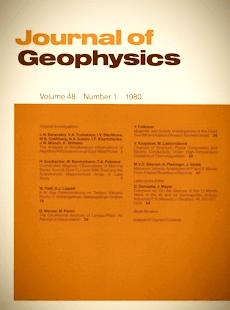Stirred remanent magnetization: a laboratory analogue of post-depositional realignment
Article Sidebar

Vols. 1-18 (1924-1944), ISSN 0044-2801
Main Article Content
Abstract
The remanent magnetization acquired by a slurry stirred in a magnetic field was measured as a function of the applied field, stirring rate and water content. The experimental results were fitted by a theoretical model in which the stirring process was approximated as a periodic randomization of the grains. The acquired remanence was proportional to the applied magnetic field and independent of the stirring rate only for weak fields ( <160 A/m) and slow stirring rates ( <10 rad/s). The remanent intensity decreased with decreasing water content. The implications for the laboratory modelling of post-depositional remanent magnetization are discussed.
 ARK: https://n2t.net/ark:/88439/y004206
ARK: https://n2t.net/ark:/88439/y004206
Permalink: https://geophysicsjournal.com/article/95
Article Details
References
Games, K.P. (1977) The magnitude of the palaeomagnetic field: a new non-thermal non detrital method using sun-dried bricks, Geophys. J. R. Astron. Soc. 48:315-329
Irving, E., Major, A. (1964) Post-depositional remanent magnetization in a synthetic sediment. Sedimentology 3:135-143
Kent, D.V. (1973) Post-depositional remanent magnetization in a deep-sea sediment. Nature 246:32-34
King, R.F. (1955) Remanent magnetization of artificially deposited sediments. Mon Not. R. Astron. Soc. [Geophys. Suppl.] 7:115-134
Lovlie, R. (1976) The intensity pattern of post-depositional remanence acquired in some marine sediments deposited during a reversal of the external magnetic field. Earth Planet. Sci. Lett. 30:209-214
Stacey, F.D. (1972) On the role of Brownian motion in the control of detrital remanent magnetization of sediments. Pure Appl. Geophys. 98:139-145
Tucker, P. (1980) A grain mobility model of post-depositional realignment, Geophys. J. R. Astron. Soc. (In press)
Verosub, K.L. (1977) Depositional and post-depositional processes in the magnetization of sediments. Rev. Geophys. Space Phys. 15:129-143
Verosub, K.L., Ensley, R.A., Ulrick, J.S. (1979) The role of water content in the magnetization of sediments. Geophys. Res. Lett. 6:226-228











